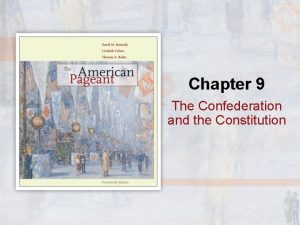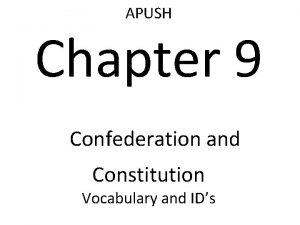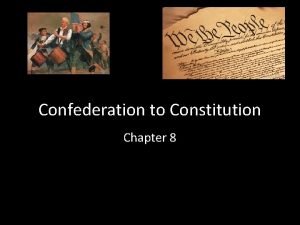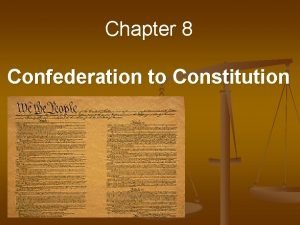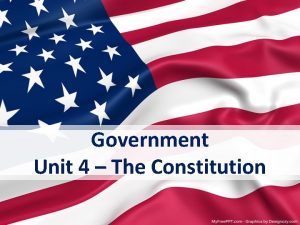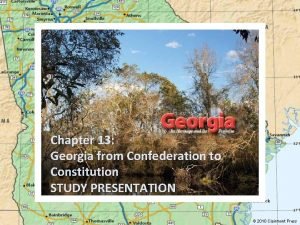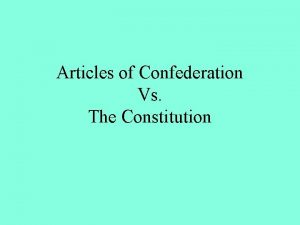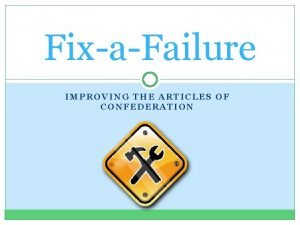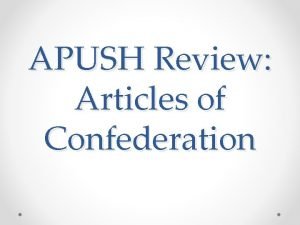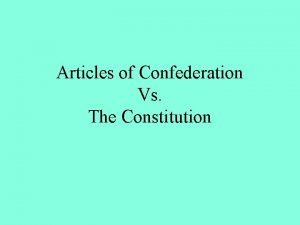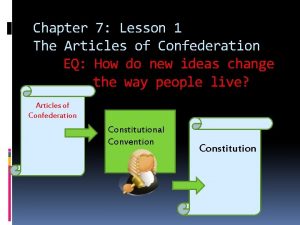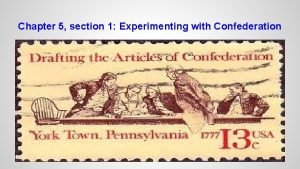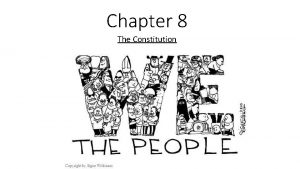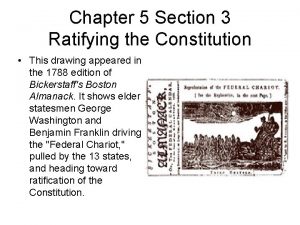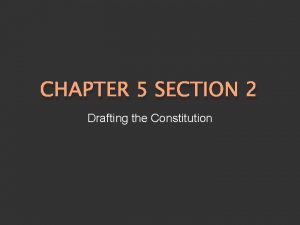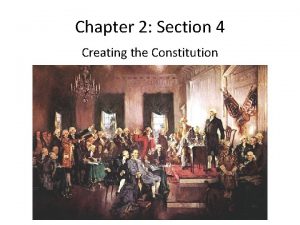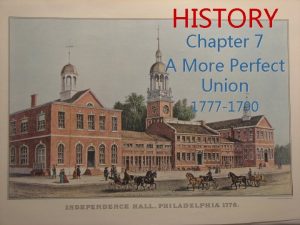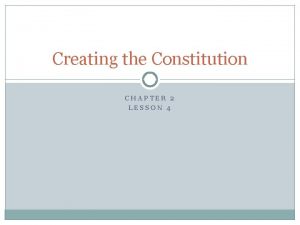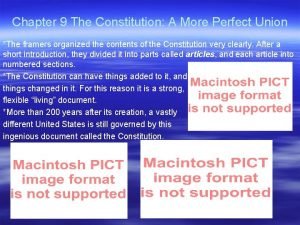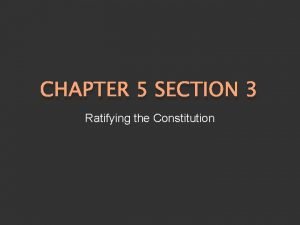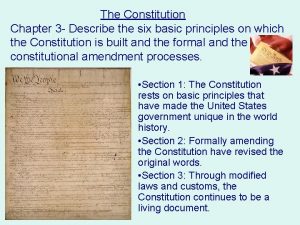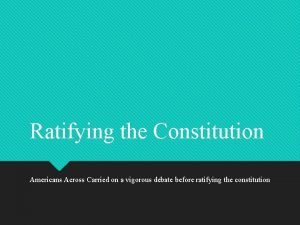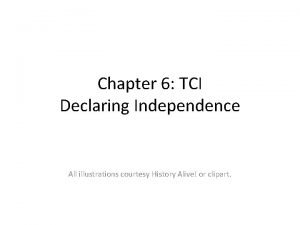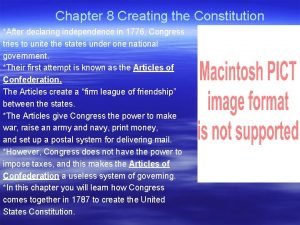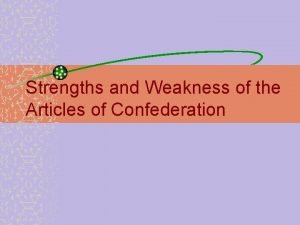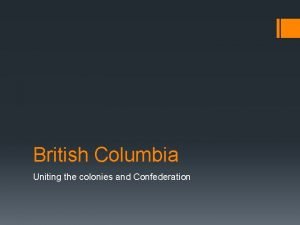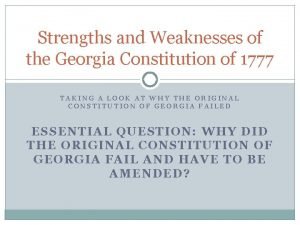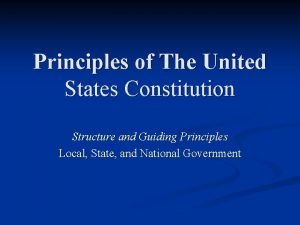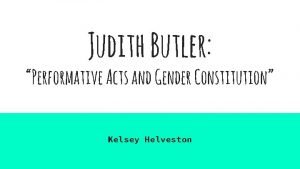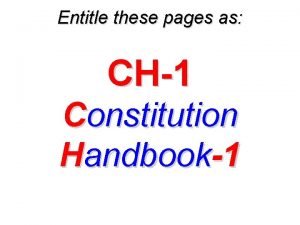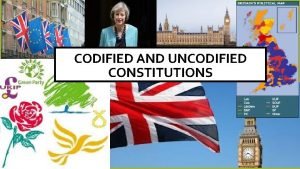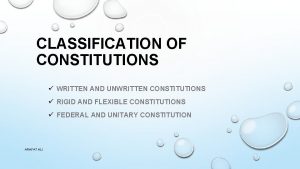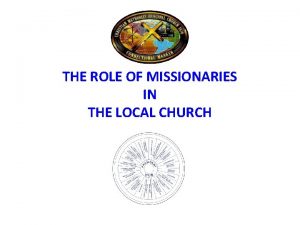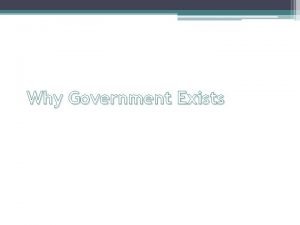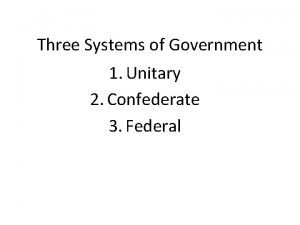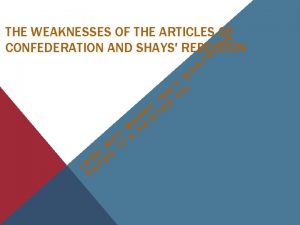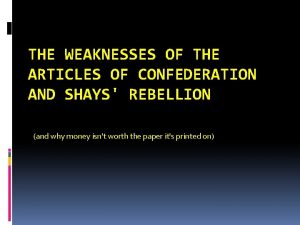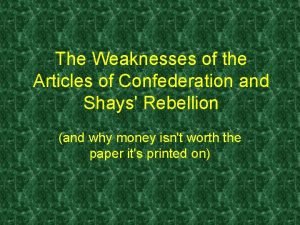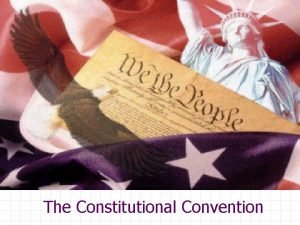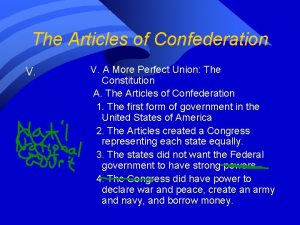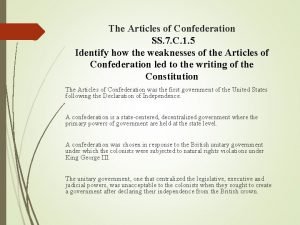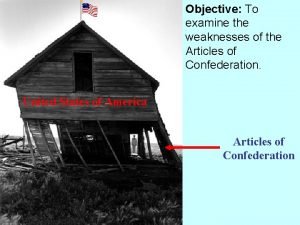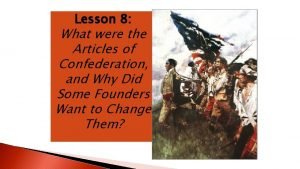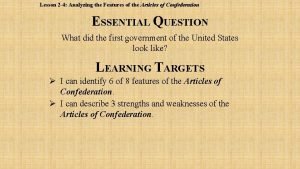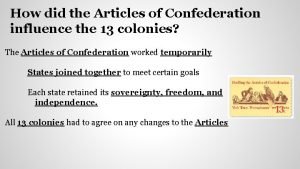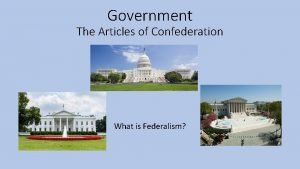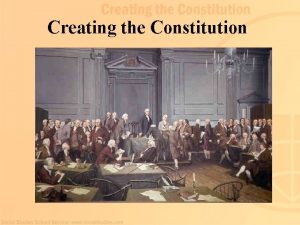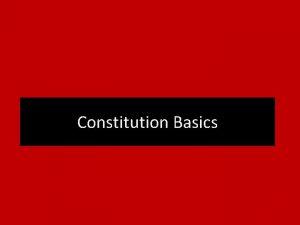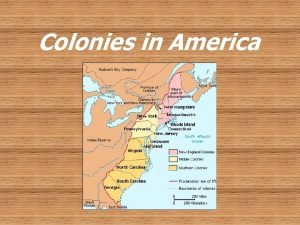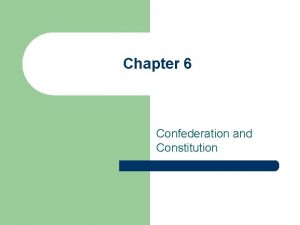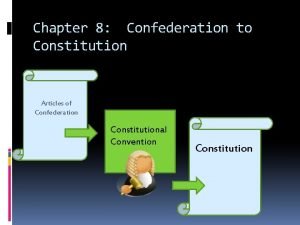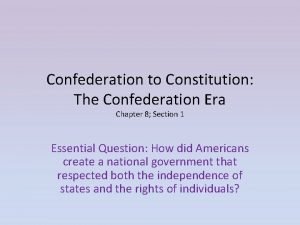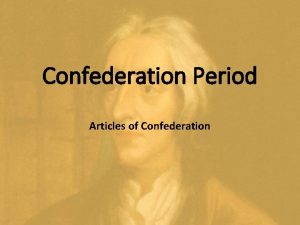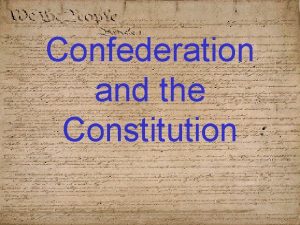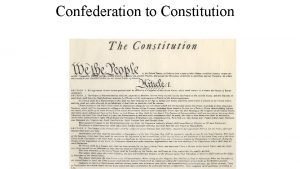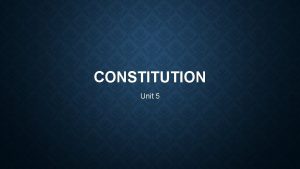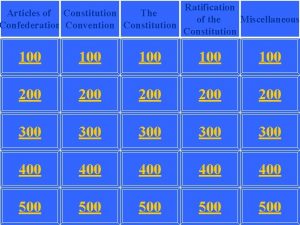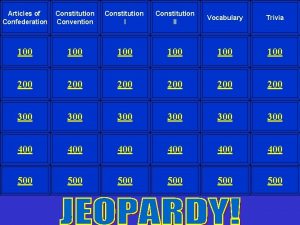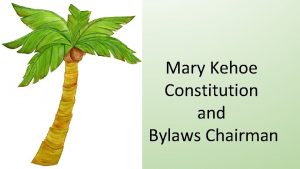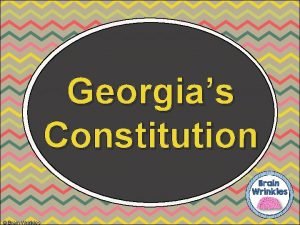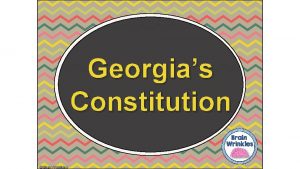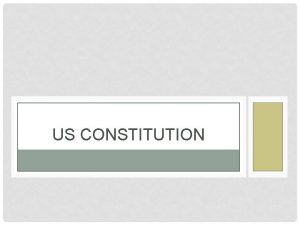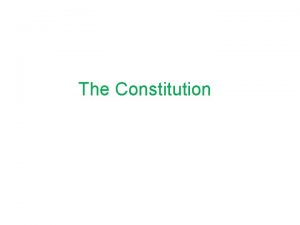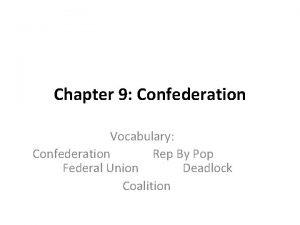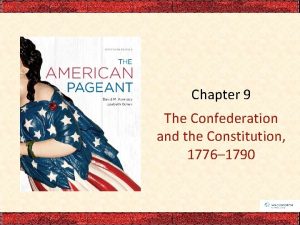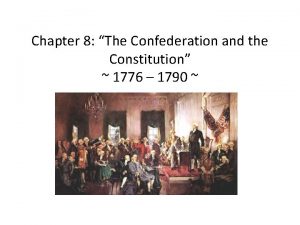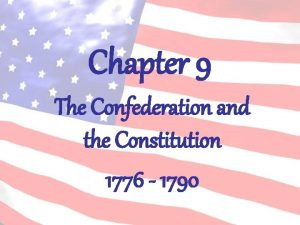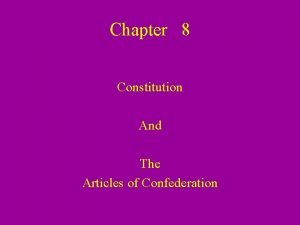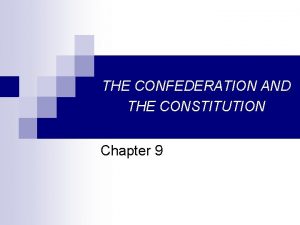CHAPTER 7 CONFEDERATION AND CONSTITUTION Chapter 7 Confederation
























































- Slides: 56

CHAPTER 7 CONFEDERATION AND CONSTITUTION

Chapter 7 – Confederation and Constitution • During the War for Independence, the colonies were governed by the Continental Congress and ______assemblies. • _________: a loose association or league of states pp. 106 -109

Chapter 7 – Confederation and Constitution Organization and Achievements of Confederation • Articles of Confederation, drafted in _____ • developed by _______of Delaware • had ____ governing body and a congress elected yearly • emphasized the _______over a strong central government pp. 106 -109

Chapter 7 – Confederation and Constitution pp. 106 -109 Adoption of the Articles of Confederation • The Articles needed to be ______ (given formal approval) by each state. • ________was the greatest contention among the states. • VA and MD were slow to ratify.

2 main reasons some states objected to the Congress taking over the lands: 1. The states with _______ land claims did not want to them up. 2. Influential land speculators were upset that they would not be able to make _____by reselling the land.

Chapter 7 – Confederation and Constitution Compromise • Congress was given control of the western lands and made them “_________. ” • Each state obtained an _______vote in congress. pp. 106 -109

Political Power under the Articles • No power to ____ • Could raise & maintain an _______ • Declare _____ • Make treaties with foreign countries • Manage _____ affairs • Est. a _____system • Borrow & coin money

Chapter 7 – Confederation and Constitution • Congress based tax assessments in the slave states on the value of improved lands rather than population. pp. 106 -109

Chapter 7 – Confederation and Constitution ______ powers • Controlled foreign and domestic trade • Ability to tax • Deal directly with foreign countries • Declare war pp. 106 -109

The states agreed to cooperate in certain issues. • Each state would respect the others’ - birth, marriage, death certificates, & wills - They would _____ criminals & runaway slaves who crossed state lines. - They would settle disputes through ________ (3 rd party)

Articles of Confederation • Laws could be passed when ____ of 13 states approved them. • The Articles themselves could be changed only with _____ consent of the states


Chapter 7 – Confederation and Constitution Lasting Achievements • The most important legislation passed by the Confederation Congress dealt with the _______lands. • Both pieces of legislation were written by _________. pp. 106 -109

Chapter 7 – Confederation and Constitution The _____________ • Northwest Territory- area bounded on the east by the original 13 colonies, on the west by the MS River, on the north by the Great Lakes, & on the south by the Ohio River • provided for ______ and selling the western lands • The ordinance divided the land into areas of 6 square miles called __________. pp. 106 -109

Chapter 7 – Confederation and Constitution The Northwest Ordinance of 1785 • Each township was subdivided into 36 smaller parcels (1 sq. mile) called ________. • Sections contained ______ acres. • The _______ section was set aside for education pp. 106 -109

Chapter 7 – Confederation and Constitution The Northwest Ordinance of 1785 • Has had a lasting effect on America • Farms & roads were laid out in straight lines & right angles (still visible today in _____& Plains states) pp. 106 -109

Chapter 7 – Confederation and Constitution p. 108

Chapter 7 – Confederation and Constitution pp. 106 -109 The ________________ • provided government for these large tracts of western lands • structure: a governor, three judges, and a secretary (all appointed by Congress)

Chapter 7 – Confederation and Constitution pp. 106 -109 The Northwest Ordinance of 1787 • _____ citizens: population with which the region could elect its own legislature • _______ citizens: population with which the region could apply for statehood (write constitution) • Guaranteed freedom of religion & forbade ______ in the Northwest Territory • The _______ River became the dividing line between slave & free states.

The _______ Record • Is the official record & proceedings in sessions of Congress.

Chapter 7 – Confederation and Constitution Unfortunately, the Confederation Congress failed in several areas. These failures, which became obvious right away, highlighted the many weaknesses of the ____________. pp. 110 -114

Chapter 7 – Confederation and Constitution pp. 110 -114 Administrative Weaknesses • inability to _____ its laws • No ______or legislative branch to enforce or interpret the laws • ______weaknesses • couldn’t tax • lacked power to regulate trade • didn’t have the sole authority to coin money

Chapter 7 – Confederation and Constitution Problems with _______ • still controlled western forts • stopped American ships • Problems with _______ and the Netherlands • unable to repay loans pp. 110 -114

Chapter 7 – Confederation and Constitution Problems with _______ • Still held land in N. America, wary of American westward expansion • Convinced local _______ that Americans would deprive them of their lands & urged raids on settlements • __________: ability to stockpile goods while awaiting export pp. 110 -114

Chapter 7 – Confederation and Constitution pp. 110 -114 Problems with Spain • Dispute over use of ports on the lower MS River (___________) • Right of deposit: ability to stockpile goods while awaiting export • Spain denied Americans this privilege • Congress appointed ________of working out the problem, paid high tariffs • Spain disputed the southern boundary, Americans drew it at the _____parallel (settled with the Pinckney Treaty)

Chapter 7 – Confederation and Constitution pp. 110 -114 Discontent at Home • Massachusetts Assembly pledged to repay war debts, in turn had to levy heavy taxes on the state’s citizens. • Crop prices are low, heavy tax burden for farmers • __________(veteran of the Continental Army): led an armed mob to destroy court records (Shays’s Rebellion) • http: //www. youtube. com/watch? v=ZEoe. K 5 Mv. Ed. Y&list= WLIrmyv-y 6 Ftyxm 5 FL 2 Lj. HAhmt. Njaqyvnr

Chapter 7 – Confederation and Constitution pp. 110 -114 _____________(1787) • Daniel Shays (veteran of the Continental Army): led an armed mob (1200) to destroy court records • Marched his men toward Springfield, were a federal arsenal was located. • 1 volley dispersed the rebels, killing 4 • Result: pointed out the _______ of the Confederation

Chapter 7 – Confederation and Constitution Preparation for Change • _________ Convention, 1786 • 5 states present • purpose: help resolve disputes between the states • Called for a convention of states in __________ pp. 110 -114

Chapter 7 – Confederation and Constitution pp. 110 -114 Philadelphia Convention, 1787 (___________ Convention) • Independence Hall, Philadelphia • Only ___ delegates, 12 states • purpose: revise the Articles of Confederation, create a national government strong enough to govern the country

Chapter 7 – Confederation and Constitution Philadelphia Convention, 1787 • chairman: __________ • decided to abandon the Articles and create a new government • Discussions kept secret from the public pp. 110 -114

Chapter 7 – Confederation and Constitution Men Who Brought Change • __________ • “America’s first political scientist” • “Father of the Constitution” • _________- led the NY delegation • _________oldest delegate present (82) pp. 110 -114

Chapter 7 – Confederation and Constitution Men Who Brought Change Not present • Thomas Jeffersonminister to _______ • John Adams- minister to ________ • JULY 4, 1826? ? ? pp. 110 -114

• The purpose of the Constitutional Convention was NOT to write the ___________. • Originally, it was to change the Articles of Confederation, but the men realized they needed a new plan of government.

Chapter 7 – Confederation and Constitution _________: a document that describes how a government is to work and gives its basic laws pp. 114 -120

Chapter 7 – Confederation and Constitution pp. 114 -120 Points of Agreement • needed a _____ central government • needed to be a _______ • Elected representatives govern the _____ • Representatives and government limited by ________

Chapter 7 – Confederation and Constitution pp. 114 -120 Points of Agreement • No one ________ should become too powerful • Rights & properties of individuals should be _______

________ • Rule by the people directly • Based on what the majority wants • Can lead to mob rule • Today there is a shift to democracy. _________ • Actually a democratic republic • The people (democratic) elect their representatives (republic). • Rules can be changed only by changing the Constitution.

Chapter 7 – Confederation and Constitution pp. 114 -120 _______________ • level of power held by central government • possibility of some states becoming too powerful • slavery and commerce

Chapter 7 – Confederation and Constitution The ____ Compromise • _______ Plan (Large State Plan) • would have two legislative houses, both based on population • ________ Plan (Small State Plan) • called for one legislative body with equal representation pp. 114 -120

Chapter 7 – Confederation and Constitution pp. 114 -120 Great Compromise (________ Compromise) • proposed by ________ • called for two legislative houses (bicameral): one with equal representation, the other based on population • ______________ • _______ (2 senators per state)

• Every _____ years the federal government would determine the population of the states by taking a census. • _____- count of the population

Chapter 7 – Confederation and Constitution pp. 114 -120 The ______ Compromise • _____: wanted tariffs to protect their industries • _____: opposed tariffs to protect their exports • Made the U. S. less dependent on foreign trade

Chapter 7 – Confederation and Constitution pp. 114 -120 The ________ Compromise • dilemma: How should congress count the slave population? • solution: counted each slave as three-fifths of a person

Chapter 7 – Confederation and Constitution The Three-Fifths Compromise • Included a promise that for ____ years Congress would make no laws interfering with slavery. • Many people believed slavery was becoming less profitable, thought it would die out. pp. 114 -120

Chapter 7 – Confederation and Constitution ________ • government powers are limited by law • Leaders cannot change their own powers according to their desires • A law is only good if it agrees with what God says. • _____________: divides the powers of government among the three branches pp. 114 -120

Chapter 7 – Confederation and Constitution pp. 114 -120 ____________ • designed to prevent the three branches from exceeding their powers • ________- led by the President, enforces laws • ________- interprets laws • ________ - makes laws • A _____ System: divided the power between the national government and the states

Chapter 7 – Confederation and Constitution pp. 121 -122 Instead of amending the Articles of Confederation, the men at the Constitutional Convention had drawn up an entirely new plan for the United States. It was nearly impossible to know how the states would receive it.

Ratifying the Constitution • ___________ • 3 delegates refused to sign it because they wanted a __________ added first. (George Mason, Edmund Randolph, Elbridge Gerry) • A Bill of Rights would guarantee _____& _______rights & freedoms to citizens.

Chapter 7 – Confederation and Constitution Ratifying the Constitution • _______: favored the adoption of the Constitution pp. 121 -122

Chapter 7 – Confederation and Constitution The _______ Papers • written by __________, John Jay, and James Madison • Collection of essays • Persuaded their states to ratify the Constitution pp. 121 -122

Chapter 7 – Confederation and Constitution __________ • worked against ratification of the Constitution • opposed a strong central government • desired a Bill of Rights • ratification: needed _______ states to approve pp. 121 -122

___________ • system to elect the President • ______________________ - 1 st Vice-President

____________ • Went into effect on December 15, 1791 • 1 st ____amendments to the Constitution • ____ amendment- grants freedom of religion, assembly, press, speech, and petition

The Constitution • The _______law of the land • More than ______ years old • Longest used constitution in the world • ________- 1 st paragraph of Constitution. “We the People”

Chapter 7 – Confederation and Constitution Reasons for Its Success - ____ principles - ______________ pp. 121 -122

____________ • National motto suggested by Benjamin Franklin • “Out of Many, One. ”
 Chapter 9 the confederation and the constitution
Chapter 9 the confederation and the constitution Chapter 9 confederation and constitution
Chapter 9 confederation and constitution Chapter 8 confederation to constitution
Chapter 8 confederation to constitution Chapter 8 confederation to constitution
Chapter 8 confederation to constitution Articles of confederation vs constitution
Articles of confederation vs constitution Articles of confederation vs constitution
Articles of confederation vs constitution Constitution vs articles of confederation
Constitution vs articles of confederation Problems with articles of confederation
Problems with articles of confederation Articles of confederation apush
Articles of confederation apush Articles of confederation vs constitution chart
Articles of confederation vs constitution chart Texas constitution vs us constitution
Texas constitution vs us constitution Nc constitution vs us constitution
Nc constitution vs us constitution Constitution what is constitution
Constitution what is constitution The constitution lesson 1 principles of the constitution
The constitution lesson 1 principles of the constitution Chapter 7 lesson 1 the articles of confederation answer key
Chapter 7 lesson 1 the articles of confederation answer key Experimenting with confederation answer key
Experimenting with confederation answer key Chapter 8 lesson 1 principles of the constitution
Chapter 8 lesson 1 principles of the constitution Ratifying the constitution chapter 5 section 3
Ratifying the constitution chapter 5 section 3 Chapter 5 section 2 drafting the constitution
Chapter 5 section 2 drafting the constitution Section 4 creating the constitution
Section 4 creating the constitution Chapter 7 lesson 2 forging a new constitution
Chapter 7 lesson 2 forging a new constitution Lesson 4 creating the constitution answers
Lesson 4 creating the constitution answers Chapter 9 the constitution a more perfect union
Chapter 9 the constitution a more perfect union Ratifying the constitution chapter 5 section 3
Ratifying the constitution chapter 5 section 3 Chapter 3 section 1 constitution scavenger hunt answers
Chapter 3 section 1 constitution scavenger hunt answers Chapter 5 section 3 ratifying the constitution answer key
Chapter 5 section 3 ratifying the constitution answer key Tci declaration of independence
Tci declaration of independence Chapter 8 creating the constitution
Chapter 8 creating the constitution Strengths of articles of confederation
Strengths of articles of confederation Articles of confederation weaknesses and strengths
Articles of confederation weaknesses and strengths British columbia confederation pros and cons
British columbia confederation pros and cons Strengths and weaknesses of the legislative branch
Strengths and weaknesses of the legislative branch Checks and balances in the constitution definition
Checks and balances in the constitution definition Judith butler performative acts
Judith butler performative acts Checks and balances in the constitution definition
Checks and balances in the constitution definition Uncodified definition
Uncodified definition Classification of constitution written and unwritten
Classification of constitution written and unwritten Women's missionary society constitution and bylaws
Women's missionary society constitution and bylaws Confederation system of government
Confederation system of government Political weaknesses of the articles of confederation
Political weaknesses of the articles of confederation Confederacy examples
Confederacy examples Government
Government Achievements of the articles of confederation
Achievements of the articles of confederation Problems with the articles of confederation
Problems with the articles of confederation Articles of confederation strengths
Articles of confederation strengths Weaknesses of articles of confederation
Weaknesses of articles of confederation Articles of confederation strengths
Articles of confederation strengths Article of confederation weakness
Article of confederation weakness Articles of confederation fail
Articles of confederation fail What was the new england confederation
What was the new england confederation Problems with articles of confederation
Problems with articles of confederation Strengths of the articles of confederation
Strengths of the articles of confederation How did the articles of confederation fail
How did the articles of confederation fail Articles of confederation fail
Articles of confederation fail Problems with the articles of confederation
Problems with the articles of confederation Weaknesses of articles of confederation
Weaknesses of articles of confederation Economy of middle colonies
Economy of middle colonies
